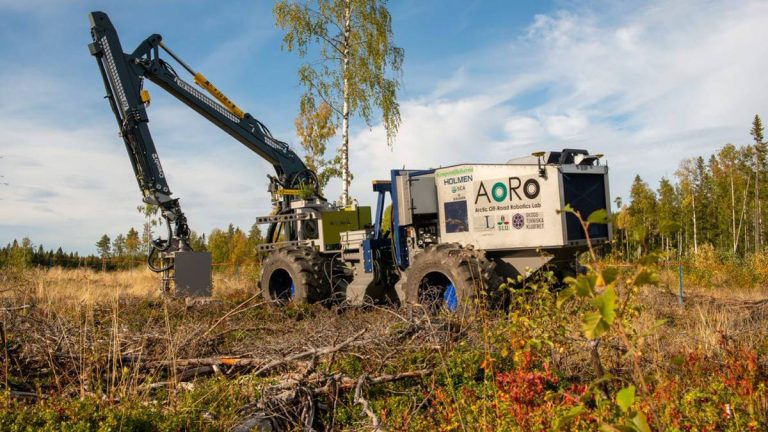The autonomous planting machine project Autoplant is getting closer to reality. In September the first test of a complete machine was made in Bräcke, mid-Sweden, close to the Bracke factory where the planting head has been developed and manufactured. The machine works, as you can see in the film below. But it will take a while before it hits the market.
Photo: Skogforsk
Autoplant – running for the first time
The project has proven that it is possible to ground prepare and plant autonomously. The project’s different parts were put together into a complete machine for the first time. The autonomous machine concept, developed by Luleå Technical University, LTU, was brought together with the planting head, developed by Bracke Forest.
The project members are researchers, users, and manufacturers. For one and a half years, hard work has been done to develop different parts of the concept.
“The field tests show great potential for an exciting development of technology for forest regeneration,” says Magnus Bergman, technical manager at SCA and chairman of the Autoplant project.
No human intervention
Bracke Forest has presented several prototypes of planting heads for ground preparation and planting. An autonomous plant feed has been developed, making it possible to conduct the whole sequence from picking the plants from storage to planting without human intervention.
“It has been challenging to develop such an advanced head with such a low weight. We are proud that our new prototype just weighs 200 kg (441 lbs.) – ten percent of the weight of our other planting heads,” says Klas-Håkan Ljungberg, CEO at Bracke Forest.
Precision and energy consumption has been important factors in the work of development. Analyzes have been made to look at the time consumption on different soil and terrain types.
The planting spot
Making the machine choose a good planting spot and bring the planting head to that spot has been a challenge. Skogforsk, the Forestry Research Institute of Sweden, has developed a “spot chooser” that operates with help of an obstacle map to find planting spots and bring the crane and the planting head to that spot.
LTU has been working with image analysis and AI to recognize stumps, stones, and slashes with a stereo camera in real time to create the obstacle map. However, much work must still be done to cope with different weather, light, terrain, and soil conditions.
Route planning is made by a solution called Pathfinder. It’s based on data from the harvester and different geodata. Choosing the right tree species for the right spot, which areas to avoid, how dense it should be planted, and the routing are tasks for the Pathfinder. Different route suggestions are presented depending on whether the machine should pick up the plants or if the plants are delivered e.g., by a drone. The machine must also be able to avoid unexpected obstacles, something that the Royal Institute of Technology, KTH, is working on.
Here is a short film from the first test, made by Skogforsk (with explaining texts in Swedish):
Financing and project members
The project is financed 50 percent by Sweden’s Innovation Agency, Vinnova. The rest by the members of the project.
The members are researchers:
Users, forestry companies:
And manufacturers:
The Cluster of Forest Technology
Source (Article in Swedish): Skogforsk, the Forestry Research Institute of Sweden












